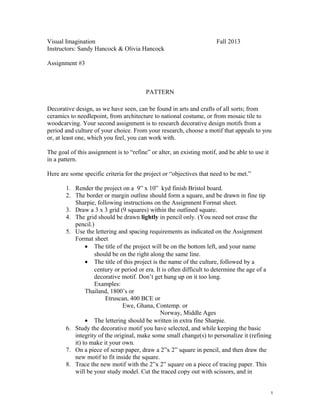
Assignment #3 pattern thinking
- 1. Visual Imagination Instructors: Sandy Hancock & Olivia Hancock Fall 2013 Assignment #3 PATTERN Decorative design, as we have seen, can be found in arts and crafts of all sorts; from ceramics to needlepoint, from architecture to national costume, or from mosaic tile to woodcarving. Your second assignment is to research decorative design motifs from a period and culture of your choice. From your research, choose a motif that appeals to you or, at least one, which you feel, you can work with. The goal of this assignment is to “refine” or alter, an existing motif, and be able to use it in a pattern. Here are some specific criteria for the project or “objectives that need to be met.” 1. Render the project on a 9” x 10” kyd finish Bristol board. 2. The border or margin outline should form a square, and be drawn in fine tip Sharpie, following instructions on the Assignment Format sheet. 3. Draw a 3 x 3 grid (9 squares) within the outlined square. 4. The grid should be drawn lightly in pencil only. (You need not erase the pencil.) 5. Use the lettering and spacing requirements as indicated on the Assignment Format sheet • The title of the project will be on the bottom left, and your name should be on the right along the same line. • The title of this project is the name of the culture, followed by a century or period or era. It is often difficult to determine the age of a decorative motif. Don’t get hung up on it too long. Examples: Thailand, 1800’s or Etruscan, 400 BCE or Ewe, Ghana, Contemp. or Norway, Middle Ages • The lettering should be written in extra fine Sharpie. 6. Study the decorative motif you have selected, and while keeping the basic integrity of the original, make some small change(s) to personalize it (refining it) to make it your own. 7. On a piece of scrap paper, draw a 2”x 2” square in pencil, and then draw the new motif to fit inside the square. 8. Trace the new motif with the 2”x 2” square on a piece of tracing paper. This will be your study model. Cut the traced copy out with scissors, and in 1
- 2. conjunction with the paper drawing develop a repeating pattern, using the following strict guidelines. • The motif must repeat itself across all nine (9) fields in one of two ways: a. In continuous, clockwise or counterclockwise 90 degree rotation b. as a continuous mirror image. • The motif must touch each adjoining motif in every square. • The motif design should have solid graphic characteristics (solid not wimpy or wispy lines) and drawn in a black sharpie(s) of your choice. • Attach a photocopy of the original motif from your research to the back of your project with regular (not “Magic”) clear tape 9. Your motif does not need to be complex or difficult to be effective. Use the skill level you are comfortable with. Your talent is welcome and appreciated, but it is not graded. Remember what counts: a. meeting the criteria b. accuracy c. neatness – do not use whiteout. 10. Asking for opinions and advice to solve a problem is very acceptable, in fact it is encouraged. Having someone do your project is fraud just like plagiarism. See assignment due date on your Syllabus. 2
